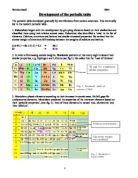Figure 1:
(A)
Properties of Gallium:
Gallium was discovered spectroscopically in 1875 by French Chemist Boisbaudran. It’s position in the periodic table is on the metal/non-metal border, making its properties unusual. Gallium shares metallic and non-metal properties; physically and chemically.
Physically, Gallium has an unusually low melting point 282.78K, making it dissimilar to most metals; and liquid in many countries at room temperature (Figure 2). Yet, it has a typically metallic, high boiling point of 2701K, thus having the largest known range of liquid temperatures. Also, Gallium is the only element that has a denser liquid state than when solid, similar to water molecules, contradicting metallic trends of high density when solid.
However, Gallium’s shiny, smooth texture makes it appear metallic. Gallium’s valency (3 outer shell electrons), combined with its electrical conductivity makes it chemically metallic4.
Figure 2:
(B)
Gallium unusually forms multiple chlorides, which involve dative covalent bonds, rarely seen in metallic compounds (they are normally ionic). Also, Gallium’s reactivity in both acids and alkalis is also characteristic of non-metals. This occurs as Gallium forms amphoteric hydroxides, which is a rare property1:
2Ga(s) + 6H+(aq) 2Ga3+(aq) + 3H2(g)
2Ga(s) + 2OH-(aq) + 6H2O(l) 2[Ga(OH)4]-(aq) + 3H2(g)
Furthering our knowledge of atomic structure using spectroscopy and the UNILAC particle accelerator:
In 1899, Ernest Rutherford proved the existence of sub-atomic particles when he proved a dense nucleus existed at the centre of atoms. He proved that this nucleus, in opposition to electrons, was dense and had a positive charge2.
Chemists, such as Bohr, quickly capitalised on this discovery and in 1913, he published his theories regarding atomic spectra, refining Rutherford’s idea of orbitals about a nucleus and proposing defined energy levels for electrons.
Emission spectra are produced by exciting electrons with an electrical arc, then allowing electrons to drop to lower energy levels and emit additional energy in the form of photons. The colour of these photons reflects their wavelength, and hence, energy. Bohr’s spectra showed that by knowing the rough structure of the atom (Figure 3), he was capable of using his spectroscopic method to investigate the energy levels more precisely.
Figure 3:
(C)
By observing spectra and using Planck’s equation for electron energy:
E = hf (D)
It is possible to decipher energy level configurations for various atoms, and identify atoms/molecules by their emission spectra (Figure 4). Such methods not only help to understand atomic configuration and the positioning of electrons, but lead to the discovery of new elements, such as Gallium6.
Figure 4:
(E)
Emission spectra are regarded as ‘fingerprints’ for atomic structure, with each atom and molecule having a unique combination of energy levels and hence a different number and variety of light wavelengths.
Another key example of modern chemical method is the UNILAC particle accelerator, which operates on the principle of high velocity, heavy ions being fired at a heavy, stable target element. Lead is used for its renowned ‘doubly magic’ stability. The purpose is to form new, artificial elements by forcing atomic nuclei to fuse (Figure 5).
Figure 5:
30Zn + 82Pb 112Element (F)
Knowing the best elements to use relies on knowledge of nuclear structure, as the modern ‘nuclear shell’ theory identifies which elements are the most stable2. With 82 protons and an isotope containing 126 neutrons, the lead has a suitably stable isotope (Figure 6).
Figure 6:
(G)
Particle acceleration is seen as the next logical step in elemental synthesis. Scientists are striving to produce element 114, which they believe will have ‘magical’ nuclear properties. It is therefore believed that synthesising element 114 will contribute greatly to knowledge of the sub-atomic particles and their relation to isotopic/nuclear stability.
From discovery to synthesis:
Previously, chemists worked to discover elements as it was the most active area for chemical breakthroughs This was due to initiatives that allowed chemists to recognise properties, such as spectroscopy3. The likes of Mendeleev, in ordering the elements and predicting new ones, also promoted new discovery.
Yet, recently, emphasis has been on the purpose of elements. Scientists have abandoned the discovery of natural materials and begun searching for synthesised alternatives. As elemental properties become more predictable, they become increasingly desirable and thus their synthesis more urgent. This was shown in the Cold War, where American and Russian scientists competed to produce more radioactive isotopes for use in weapons.
Particle accelerators, such as the UNILAC have been pivotal in the formation of heavier elements and are seen as vital in achieving what is often referred to as ‘the holy grail of elements’ – element 114, which would lead to breakthroughs in knowledge about atomic structure and stability2. Such efforts to create new elements have labelled particle chemists: ‘the new alchemists’(H).







